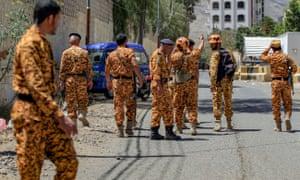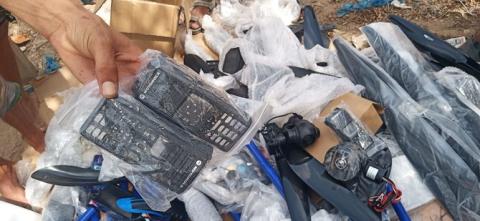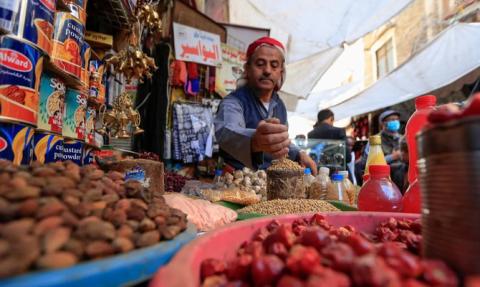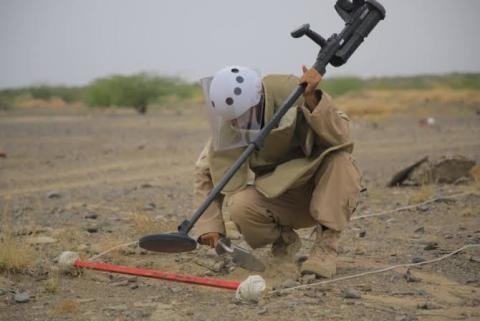Ten years after the Arab spring, Yemen has little hope left
Ten years after the rage and hope of the Arab spring filled the public spaces of Sana’a, Yemen’s capital has become a curiously quiet place.
Traders and customers alike shuffle through the streets of the old city, ground down by the repression of the Houthi rebel occupation and the economic hardship caused by the Saudi- and Emirati-led coalition blockade.
The songs and poems of revolution that once echoed beneath the charming medieval architecture have faded away, replaced by the Houthi sarkha, or scream, daubed in red and green on almost every surface: “God is great, death to America, death to Israel, curses on the Jews, victory to Islam.”
On occasion, and always without warning, the tension is pierced by coalition airstrikes.
A decade since Yemenis dared to dream during the 2011 uprisings that swept across the Arab world, and six years after foreign actors piled in, unleashing a war of devastating proportions, Yemen resembles a jigsaw puzzle for which there is no simple solution.
As the conflict grinds on, the accompanying humanitarian crisis is on the verge of a terrible new zenith, in the form of the worst famine the world has witnessed in 40 years.
The possibility that the jigsaw pieces can fit back together again is becoming more and more remote.
Ten years ago last month, more than 10,000 people took to Sana’a’s streets in the first mass demonstration against the corruption and cruelty of President Ali Abdullah Saleh’s 32-year-old regime.
Inspired by the early successes of the revolutionary movement in Tunisia, citizens from all walks of life embarked on a mostly peaceful march through the city, waving flags and wearing pink armbands and scarves in a show of unity.
Saleh stepped down in early 2012, finally vacating a job he described as like “dancing on the heads of snakes”. (In 2017, he would meet his end in the same manner as Muammar Gaddafi, a bloodied corpse dragged through the streets, after he tried to switch sides in the war.)
“It was so powerful and intoxicating, that feeling that for the first time ever, people in Yemen were unified. It didn’t matter what your tribe or religious or political affiliation was, the gender dynamic, we all showed up together, week after week,” said Raja al-Thaibani, a Yemeni-American who put her university studies on hold in 2011 to participate in the uprising.
“A few months in, the cracks in that unity started to show, but I think a lot of us refused to acknowledge it.”
In the political and security vacuum that followed, several actors posing a threat to the fragile state’s integrity gained ground: in the northern highlands, the long-simmering Houthi insurgency; in the central deserts, al-Qaida; and in Aden, Yemen’s second city, a movement for renewed independence for south Yemen.Full-scale conflict erupted when the Houthis, a Zaydi Shia militant group, decided to storm the capital, forcing the interim president, Abdrabbuh Mansur Hadi, to flee to neighbouring Saudi Arabia in early 2015.
Hadi arrived at the same time that a 29-year-old prince by the name of Mohammed bin Salman was clawing his way to power, encouraged by his mentor, the de facto Emirati ruler Sheikh Mohammed bin Zayed Al Nahyan.
Under Prince Mohammed’s leadership as defence minister, and later as crown prince, the Saudis – alarmed by the prospect of an empowered Iranian ally on their border – heeded the exiled Yemeni government’s call for help.
With the advice and support of western allies including the UK and the US, Saudi military commanders, never before tested in fighting wars, decided on a three-week bombing campaign to drive the Houthis out of Sana’a.
Operation Decisive Storm has instead morphed into a stalemated conflict that now stretches across 47 frontlines and has claimed 233,000 lives.
Far from the gleaming palaces of Riyadh and Abu Dhabi, the coalition’s military ambitions have come unstuck in the badlands of the Arabian peninsula, but it is Yemeni civilians who have paid the price.
Weddings, hospitals and a bus full of schoolchildren have all become bombing targets: in Saada province, the Houthi heartland, airstrikes have become such a mundane part of daily life that people no longer pay any attention to the whine of fighter jets overhead.
Malnutrition, cholera, dengue fever, and now coronavirus stalk the young and the frail in what the UN has called the “worst humanitarian crisis in the world”.The main reason widespread famine has not been declared is because meeting the complex technical definition requires quality data, which Yemen lacks.
“The Houthis in the north, and their Iranian backers, are not going anywhere,” said Mahdi Balghaith, an analyst with the Sana’a Center for Strategic Studies thinktank, during the Guardian’s last visit to Yemen in November.
“They are ready to play the long game in a way the Gulf powers are not. In the future, the US will not be reliant on the Gulf for oil and gas any more and that longstanding partnership will disintegrate. Then what would stop Tehran from marching north to Mecca itself?”
In Yemen’s diverse south, the dust has not yet settled, but Mohammed bin Salman and Mohammed bin Zayed have alienated potential allies.
On a chilly evening last year in Shabwa province, an oil-rich geographical linchpin connecting the north of the country to the south, purple shadows danced in the space between the glow of red-hot coals and a darkening sky as tribal leaders lined up to greet a convoy of Land Cruisers making its way across the desert.
More than 100 men from Shabwa’s 10 clans had gathered for a protest sit-in near a UAE military base, demanding justice for nine men and boys killed by an airstrike during an unprovoked attack by Emirati-backed forces. Sometimes, they said, an Emirati fighter jet will swoop low over the camp in an effort to scare them away.
The guardian




